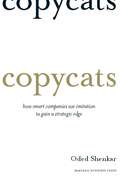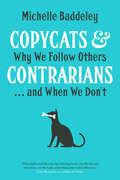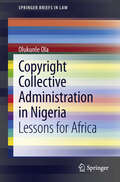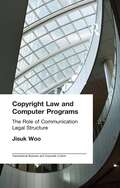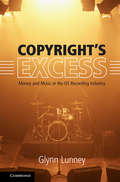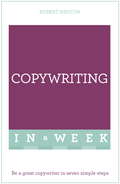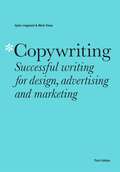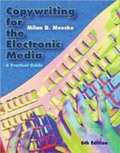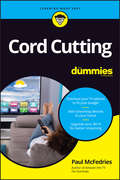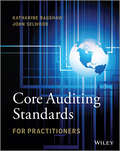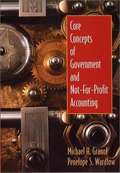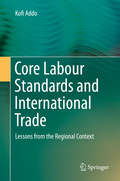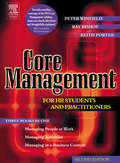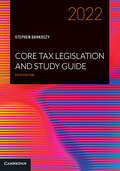- Table View
- List View
Copy, Copy, Copy
by Mark Earls John V. WillshireTHE #1 HACK FOR SMARTER MARKETINGWe all want new answers and new solutions for the very real and pressing challenges that our organizations face. New things to point to and talk about, new ways of working and new ways of thinking that might just be better than the old ways. But rather than this endless search for a brilliant and novel solution, why don't you just copy something that's worked before? Mark Earls, leading expert in marketing and consumer behaviour, quashes the stigma around copying, and shows that it can help us to rethink how we go about solving problems. By understanding what other people are doing and the choices they make, we can develop strategies to solve the challenges that we face inside and outside the organization.Based on extensive research and proven examples, Copy, Copy, Copy provides over 50 strategies that you can use right away to copy, borrow or steal as the basis for better ideas - faster. If it's good enough for Elvis, Newton, Shakespeare, The British Olympic Cycling Team and Great Ormond Street Hospital, isn't it good enough for you? 'This delightful book argues convincingly that transferring ideas usually produces greater value than cooking them up from scratch. And then shows you how.' -- Rory Sutherland, Vice Chairman, Ogilvy London and the Spectator Magazine's Wikiman 'Yet another entertaining handbook from the acclaimed Herdmeister for anyone involved in marketing, behavioural change and understanding why we all make the choices we make. Earls convincingly disrupts convention about what is innovation - though "praxis". This is jammed with great case studies and 52 actionable strategies.' -- Stephen Maher, Chairman, The Marketing Society and CEO, MBA 'Yet again this leading British business thinker has got us to see the world we inhabit today in fresh and mind-altering ways. A book which marries theory and practice better than the vast majority out there. Most of all his message of copying one's way to greatness is entertaining, counter-intuitive and fun.' -- David Abraham, CEO Channel 4 PLC
Copycats
by Oded ShenkarIn the business world, imitation gets a bad rap. We see imitating firms as ?me too? players, forced to copy because they have nothing original to offer. We pity their fate: a life of picking up crumbs discarded by innovators striding a path paved with fame and profit.In Copycats, Oded Shenkar challenges this viewpoint. He reveals how imitation?the exact or broad-brushed copying of an innovation?is as critical to prosperity as innovation.Shenkar shows how savvy imitators generate huge profits. They save not only on R&D costs but also on marketing and advertising investments made by first movers. And they avoid costly errors by observing and learning from others? trials.Copycats presents suggestions for making imitation a core element in your competitive strategy and pairing it powerfully with innovation, including:· How to select the right model to imitate· How to avoid oversimplification of a model· Which imitation strategy to use· How to prepare and execute an implementation planEngaging, practical, and rich in company examples, Copycats unveils how to add imitation to your competitive arsenal.
Copycats & Contrarians: Why We Follow Others . . . and When We Don't
by Michelle Baddeley&“Why we run with—or avoid—the crowd, and why it matters, from choosing a restaurant in a tourist trap to believing fake news. I learned a lot&” (Tim Harford, author of The Undercover Economist). Rioting teenagers, tumbling stock markets, and the spread of religious terrorism appear to have little in common, but all are driven by the same basic instincts: the tendency to herd, follow, and imitate others. In today&’s interconnected world, group choices all too often seem maladaptive. With unprecedented speed, information—or misinformation—flashes across the globe and drives rapid shifts in group opinion. Adverse results can include speculative economic bubbles, irrational denigration of scientists and other experts, seismic political reversals, and more. Drawing on insights from across the social, behavioral, and natural sciences, Michelle Baddeley explores contexts in which behavior is driven by the herd. She analyzes the rational vs. nonrational and cognitive vs. emotional forces involved, and she investigates why herding only sometimes works out well. With new perspectives on followers, leaders, and the pros and cons of herd behavior, Baddeley shines vivid light on human behavior in the context of our ever-more-connected world. &“Her observations on how both risk-taking and conformism contributed to Donald Trump&’s election, and on how social media affects &‘copycats,&’ make for a well-timed and valuable study.&” —Publishers Weekly &“This might well become the defining book, for this decade and more, on the topic of herding and social influence.&” —Cass Sunstein, co-author of Nudge
Copyright Collective Administration in Nigeria: Lessons for Africa (SpringerBriefs in Law)
by Olukunle OlaThis work explores the operation and regulation of copyright collective management in Nigeria. The nexus between creativity and copyright and how creativity has played a pivotal role in development is explained. The need to balance the interests of authors and users is discussed and the societies representing the interest of copyright owners are illustrated. Further, Nigeria's legal framework for collective management is enunciated from a pre-independence and post-independence perspective. In the course of this regulatory challenges encountered in the administration of collective management organizations, steps so far taken to address the problems, legislative reforms and judicial decisions are discussed. A path to the new regime is chartered. The South African Copyright collective management system is explored and a comparison between the Nigerian and South African system is made. Thereby the need for supervisory and regulatory agencies of government is shown to seek the national interest regarding the collective administration of copyright and related rights. Then, suggestions for improvement and lessons for Africa are provided.
Copyright Law and Computer Programs: The Role of Communication in Legal Structure (Transnational Business and Corporate Culture)
by Jisuk WooFirst Published in 2000. Routledge is an imprint of Taylor & Francis, an informa company.
Copyright’s Excess: Money and Music in the U. S. Recording Industry
by Glynn LunneyFor more than 200 years, copyright in the United States has rested on a simple premise: more copyright will lead to more money for copyright owners, and more money will lead to more original works of authorship. In this important, illuminating book, Glynn Lunney tests that premise by tracking the rise and fall of the sound recording copyright from 1961 to 2015, along with the associated rise and fall in sales of recorded music. Far from supporting copyright’s fundamental premise, the empirical evidence finds the exact opposite relationship: more revenue led to fewer and lower-quality hit songs. Lunney’s breakthrough research shows that what copyright does is vastly increase the earnings of our most popular artists and songs Doing so reduced their productivity. At the same time, copyright did very little to increase the earnings of, and hence increase the productivity of, artists at the margins. The net result: more revenue was associated with the release of fewer hit songs. This book should be read by anyone interested in how copyright operates in the real world.
Copywriting In A Week: Be A Great Copywriter In Seven Simple Steps
by Robert Ashton Rob AshtonGreat copywriting just got easierIt's strange to think that there was a time when only the privileged few could read or write. The rest of us relied on the spoken word. Storytelling was used to pass knowledge on from one generation to the next. Now, most of us are literate and use the written word to gather information and inform our decision making. Increasingly we do this online, with social media and messaging enabling rapid, spontaneous global communication. But rather than freeing us from the need for clear, effective written communication, it actually makes good communication even more important. The less we communicate face to face, the greater the opportunity for misunderstandings. Of course, all writing communicates your message to people you cannot see and may never meet. It means you can influence more widely; it also means you must take care not to make assumptions aboutyour reader, especially those who see your public postings. Successful copywriting is constructed from carefully selected words, each with a clear purpose. It is written to prompt feelings, thoughts or actions. It is clear, concise and at times comforting. It is also comprehensible, even to those not yet confident users of your language. Reading this book, and following the techniques it introduces, will make you a more effective writer. Expertise in grammar is not needed as all the necessary jargon is simply defined and, anyway, some forms of business writing deliberately ignorerules. This book is for people who want to write for results. Each of the seven chapters in Copywriting In A Week covers a different aspect:- Sunday: Focusing your message- Monday: Using layout, pictures and colour to make words memorable- Tuesday: Writing effective letters- Wednesday: Making advertising work for you- Thursday: Communicating clearly with the media- Friday: Preparing promotional print- Saturday: Composing proposals and presentation visuals
Copywriting In A Week: Be A Great Copywriter In Seven Simple Steps
by Robert AshtonThe ability to write great copy is crucial to anyone who wants to advance their career.Written by Robert Ashton, a leading expert on copywriting as both a coach and a practitioner, this book quickly teaches you the insider secrets you need to know to in order to write brilliant copy.The highly motivational 'in a week' structure of the book provides seven straightforward chapters explaining the key points, and at the end there are optional questions to ensure you have taken it all in. There are also cartoons and diagrams throughout, to help make this book a more enjoyable and effective learning experience.So what are you waiting for? Let this book put you on the fast track to success!
Copywriting Strategies: A No-Nonsense Guide to Writing Persuasive Copy for Your Business
by Nicki KrawczykMaster the strategies for successful copywriting Messaging is the single most important factor in the success of any business or endeavor. This invaluable book will teach you strategies for identifying your target consumer, creating a strong message, and writing powerful copy that connects your message with your audience.What sets this copywriter's handbook apart from other copywriting books:Copywriting 101—Learn the essentials for crafting persuasive copy, including the Ten Commandments of copywriting, common misconceptions, and writing in the digital age.Fundamental strategies—Put principles into practice with strategy sessions, real-life examples of great copywriting, and a call to action that challenges you to use what you've learned.But wait, there's more—Build on your new copywriting skills with specific tips to create marketing communications for your branding, websites, emails, digital ads, social posts, and more.Discover how to reach your audience through persuasive copywriting using the lessons and examples found in this strategic copywriter's guide.
Copywriting Third Edition: Successful writing for design, advertising and marketing
by Mark Shaw Gyles LingwoodWriting copy is often assumed to be a natural talent. However, there are simple techniques you can employ to craft strong written content with ease. This revised edition teaches the art of writing great copy for digital media, branding, advertising, direct marketing, retailing, catalogues, company magazines and internal communications, and aspects of writing for social media are integrated throughout. There are also new interviews and case studies. Using a series of exercises and up-to-date illustrated examples of award-winning campaigns and communication, *Copywriting, Third Edition takes you through step-by-step processes that can help you to write content quickly and effectively.
Copywriting Third Edition: Successful writing for design, advertising and marketing
by Mark Shaw Gyles LingwoodWriting copy is often assumed to be a natural talent. However, there are simple techniques you can employ to craft strong written content with ease. This revised edition teaches the art of writing great copy for digital media, branding, advertising, direct marketing, retailing, catalogues, company magazines and internal communications, and aspects of writing for social media are integrated throughout. There are also new interviews and case studies. Using a series of exercises and up-to-date illustrated examples of award-winning campaigns and communication, *Copywriting, Third Edition takes you through step-by-step processes that can help you to write content quickly and effectively.
Copywriting for the Electronic Media: A Practical Guide (6th edition)
by Milan D. MeeskeThis text for undergraduates offers ample copywriting practice with about 80 exercises that sharpen copywriting skills in a variety of venues. Realistic situations typical of entry-level copywriting positions are included. The structure of the text is appropriate for an introduction to writing for electronic media, where many topics are covered, or it can be used to focus on writing for radio and television alone. Along with copywriting materials, the text includes material not always found in texts, such as chapters on copywriting style, consumer behavior, and legal and ethical aspects of copywriting. B&w examples of storyboards and actual aired copy are used extensively. This sixth edition contains new material on getting the first job and the role of the Internet. The grammar review has been expanded and simplified for this edition. Meeske is professor emeritus at the University of Central Florida. Annotation ©2008 Book News, Inc. , Portland, OR (booknews. com)
Copywriting: Bullet Guides
by Tina KonstantOpen this book and you will Compose great copy Engage your audience Persuade brilliantly Build sales
Copywriting: Bullet Guides
by Tina KonstantOpen this book and you will Compose great copy Engage your audience Persuade brilliantly Build sales
Coral Reefs
by Seymour SimonSeymour Simon knows how to explain science to kids and make it fun. He was a teacher for more than twenty years, has written more than 250 books, and has won multiple awards. <P><P>In Coral Reefs, Simon introduces elementary-school readers to the oceans’ reefs through wonderful descriptions and stunning full-color photographs. He encourages appreciation of the ecology of coral reefs, explains why they are in danger, and suggests ways kids can help save the endangered reefs. Lexile Measure: NC1110L
Cord Cutting For Dummies
by Paul McFedriesCut the cable television cord and cut your monthly bills Are you one of those people who have 500 television channels to choose from and you can never find anything to watch? Maybe it’s time to cut the cable cord and take full control of what’s on your television. All you need to get started with this popular money saving strategy is an Internet connection, a device to stream to, and the advice in this book. With Cord Cutting For Dummies, you go from evaluating if cord cutting is the right choice for your budget to acquiring the technology to get the programming you actually want. You’ll discover the technology you need for streaming, select the service or services that fit your needs, and make the components of your setup work together—all within your budget. Cord Cutting For Dummies offers the steps to going from wired to wireless, including: Deciding if you need to upgrade your Wi-Fi equipment and service. Evaluating your current devices. Adding a smart TV to the mix. Choosing the best streaming services for you—including some free options When you’re ready to untether yourself from the cable or satellite, Cord Cutting For Dummies shows you, step by step, how to break free. Pick up a copy and you’ll be watching your favorite movie or TV show in no time!
Core Auditing Standards for Practitioners
by Katharine Bagshaw John SelwoodThe only book on the market specifically designed to help audit staff stay ahead of inspectorsThis comprehensive, practical, and theoretical guide covers the key ISAs that underpin audit methodologies and the recently revised ISAs that cause practitioners the most concern. It is designed to enhance auditors' understanding of critical ISAs, reducing their dependence on methodologies to mediate and explain ISA requirements. Using plenty of examples, the book helps audit staff learn to tailor audit methodologies and remove redundancies, as well as form high-quality judgments with a thorough grounding in ISA to serve in discussions with file reviewers and audit inspectors.Features practical examples that appeal to auditors with technical responsibilitiesCovers key topics such as smaller audits, management override of controls, documenting judgments, and dealing with accounting estimates and written presentationsIdeal for practitioners in companies and accounting firms, as well as auditing studentsIncludes access to a companion website with constantly updating ISAs and case studiesMixing theory with practical examples, Core Auditing Standards for Practitioners provides experienced audit staff with key ISA-related information they need to succeed.
Core Brand Message: How to Build a Unique Brand
by Mike MoserThe core brand message is the key message that your company will be communicating to all its audiences. All other messages coming from the company will be offshoots of this message. This chapter will take you through a process that will ensure that the brand message you come up with will work in the marketplace for years to come.
Core Brand Values: How to Build a Unique Brand
by Mike MoserThis chapter will help you articulate your company's core brand values, which make up the foundation for every decision your company makes-from the kind of people you hire, to the kinds of customers you pursue, to the marketing decisions you make. A worksheet to guide you through the process is included.
Core Competence of the Corporation (HBR Bestseller)
by Gary Hamel C. K. PrahaladA company's competitiveness derives from its core competencies and core products. Core competence is the collective learning in the organization, especially the capacity to coordinate diverse production skills and integrate streams of technologies. First companies must identify core competencies, which provide potential access to a wide variety of markets, make a contribution to the customer benefits of the product, and are difficult for competitors to imitate. Next companies must reorganize to learn from alliances and focus on internal development. McKinsey Award Winner.
Core Concepts of Government & Not-for-Profit Accounting
by Penelope S. Wardlow Michael H. GranofWe wrote this text for graduate and upper-level undergraduate accounting courses and graduate courses in public administration and public affairs.
Core Labour Standards and International Trade: Lessons from the Regional Context
by Kofi AddoThis book examines the labour standards provisions in a number of Regional and Bilateral Trade Agreements, and assesses the potential of using the relevant clauses in these trade agreements as a benchmark for a multilateral approach. Based on the lessons learned from the Regional model, the book proposes a Global Labour and Trade Framework Agreement (GLTFA) combined with a joint ILO/WTO enforcement mechanism to resolve the contentious issue of the link between the CLS and international trade. The history of the linkage between the Core Labour Standards (CLS) and international trade dates back roughly 150 years, and has recently become one of the most vexing issues facing policy-makers. At the heart of the debate is the question whether or not trade sanctions should be imposed on countries that do not respect the CLS as embodied in multilateral conventions administered by the International Labour Organization (ILO). Concretely, this would entail inserting a social clause in the World Trade Organization (WTO) rules, and would trigger the imposition of sanctions on those countries that do not adhere to the CLS.
Core Macroeconomics (3rd Edition)
by Eric P. Chiang Gerald W. StoneWith this new edition, Eric Chiang transforms CoreMacroeconomics into a text/media resource well attuned to today’s students. Long active in the economics education community, Chiang brings a contemporary teacher’s perspective to the book, supporting a variety of learning approaches by introducing modern topics, new pedagogy, a more visual presentation, and well-integrated media tools. All this while maintaining the book’s defining focus on just those topics instructors cover most often in the course.
Core Management for HR Students and Practitioners
by Peter Winfield Ray Bishop Keith PorterThis is the second edition of the successful text published in 2000.The text continues to include self- assessment exercises, exam question, further reading and research and uses short case studies and articles to relate theory to practice.The new edition is completely up-dated with more extracts from Personnel Today and linked in to a website provided by the authors. The book provides excellent coverage of the CIPD syllabus for three core areas of the CIPD syllabus, Managing People, Managing Activities and Managing a business context. New end of chapter website links are included.
Core Tax Legislation and Study Guide 2022 Core Tax Legislation and Study Guide 2022
by Stephen BarkoczyCore Taxation Legislation and Study Guide is a reference text for students undertaking tax subjects. It provides curated extracts of legislation as well as useful guidance on study skills. Part 1: The Study Guide assists students to prepare for a tertiary taxation course and conduct basic taxation research. It refers to key reference material, including websites and research tools, and includes useful tips on study techniques, researching a tax problem, essay writing and presentation, answering taxation law exam questions and how to cite legislation, cases, articles, rulings and reports for assignments. Part 2: The Core Tax Legislation comprises selected extracts from relevant sections of taxation legislation and regulations. An essential resource, this text allows students to access the parts of the legislation they will need for a taxation law course in a time-saving and user-friendly way. Core Taxation Legislation and Study Guide 2022 is designed to be used in conjunction with Foundations of Taxation Law 2022.

